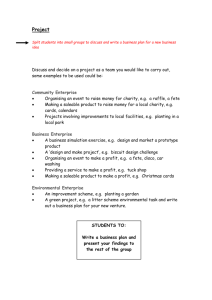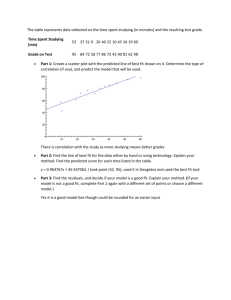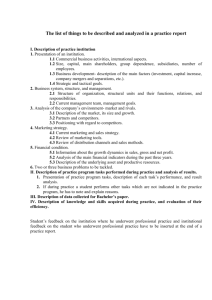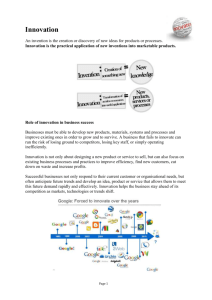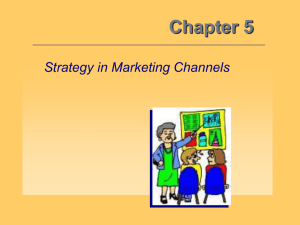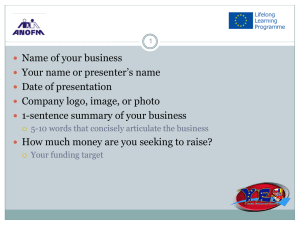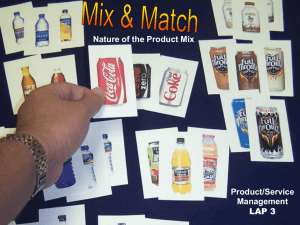Uittreksel Marketing Management (Philip Kotler)
advertisement
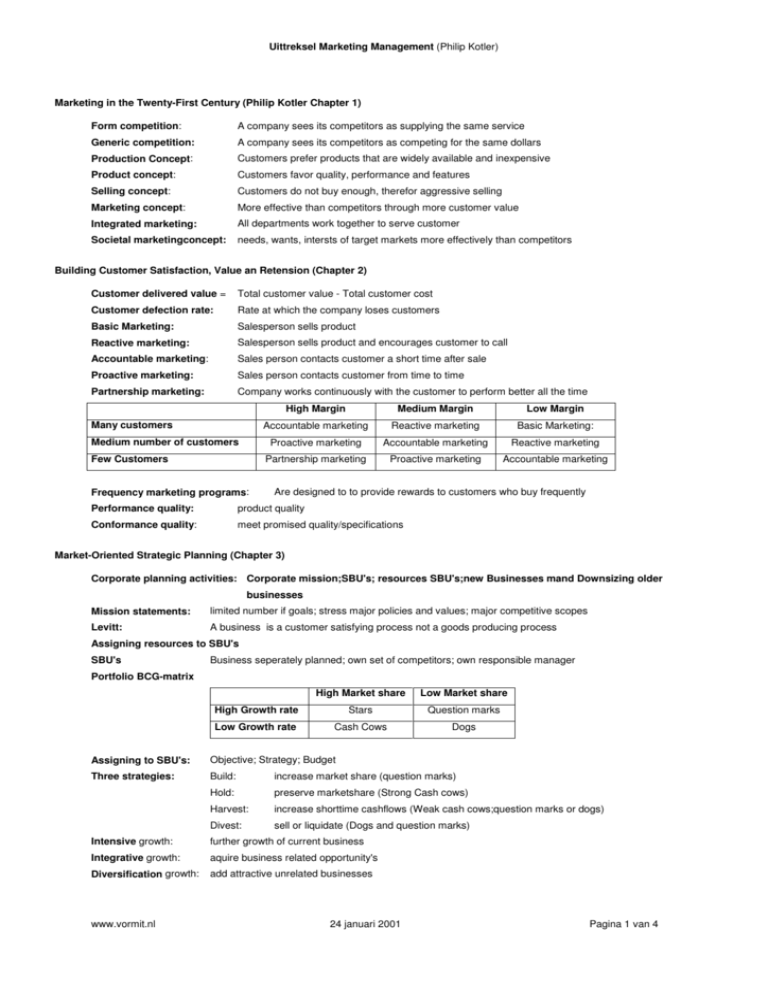
Uittreksel Marketing Management (Philip Kotler)
Marketing in the Twenty-First Century (Philip Kotler Chapter 1)
Form competition:
A company sees its competitors as supplying the same service
Generic competition:
A company sees its competitors as competing for the same dollars
Production Concept:
Customers prefer products that are widely available and inexpensive
Product concept:
Customers favor quality, performance and features
Selling concept:
Customers do not buy enough, therefor aggressive selling
Marketing concept:
More effective than competitors through more customer value
Integrated marketing:
All departments work together to serve customer
Societal marketingconcept:
needs, wants, intersts of target markets more effectively than competitors
Building Customer Satisfaction, Value an Retension (Chapter 2)
Customer delivered value =
Total customer value - Total customer cost
Customer defection rate:
Rate at which the company loses customers
Basic Marketing:
Salesperson sells product
Reactive marketing:
Salesperson sells product and encourages customer to call
Accountable marketing:
Sales person contacts customer a short time after sale
Proactive marketing:
Sales person contacts customer from time to time
Partnership marketing:
Company works continuously with the customer to perform better all the time
Many customers
Medium number of customers
Few Customers
Frequency marketing programs:
High Margin
Medium Margin
Low Margin
Accountable marketing
Reactive marketing
Basic Marketing:
Proactive marketing
Accountable marketing
Reactive marketing
Partnership marketing
Proactive marketing
Accountable marketing
Are designed to to provide rewards to customers who buy frequently
Performance quality:
product quality
Conformance quality:
meet promised quality/specifications
Market-Oriented Strategic Planning (Chapter 3)
Corporate planning activities: Corporate mission;SBU's; resources SBU's;new Businesses mand Downsizing older
businesses
Mission statements:
limited number if goals; stress major policies and values; major competitive scopes
Levitt:
A business is a customer satisfying process not a goods producing process
Assigning resources to SBU's
SBU's
Business seperately planned; own set of competitors; own responsible manager
Portfolio BCG-matrix
Assigning to SBU's:
Three strategies:
High Market share
Low Market share
High Growth rate
Stars
Question marks
Low Growth rate
Cash Cows
Dogs
Objective; Strategy; Budget
Build:
increase market share (question marks)
Hold:
preserve marketshare (Strong Cash cows)
Harvest:
increase shorttime cashflows (Weak cash cows;question marks or dogs)
Divest:
sell or liquidate (Dogs and question marks)
Intensive growth:
further growth of current business
Integrative growth:
aquire business related opportunity's
Diversification growth:
add attractive unrelated businesses
www.vormit.nl
24 januari 2001
Pagina 1 van 4
Uittreksel Marketing Management (Philip Kotler)
Gathering Information and Measuring Market Demand (Chapter 4)
Marketing Information System (MIS):
Internal Records System(order to payment cycle;EDI;intranets);
Sales Information System
Marketing Intelligence System:
set of procedures and sources to obtain everyday information about environment
Marketing Research Syatem:
systematic design, collection, analysis and reporting of data and findings relevant to a
Marketing Research Process:
Define problem and research objectives; develop plan; collect information; analyze
Exploratory research:
Explore nature of problem and give solution
Descriptive research:
Gives magnitudes
speciofic marketing situation
information; present findings
Causal:
Cause-effect-relationships
Secondary data:
Data collected for another purpose
Primary data collection:
observation; focus groups; surveys; behavioral data; expiriments
Marketing Decision Support System:
coördinated collection by which an organization gathers and interprets relevant
information into marketing action
customers who profess a sufficient level of interest to an market offer
Potential market:
Available market:
customers who have interest, income and access to an market offer
Qualified available market:
Available market with qualifications (above 21)
Target:
the part of the qualified available market the company decides to pursue
Penetrated Market:
Customers that are buying the company's product
Scanning the Marketing Environment (Chapter 5)
Fad:
Unpredictable , short-lived without social, economic and political significance
Trends:
Predictable and durable
Megatrends:
Large social, economic, political, an technological changes slow to form but in place they influence us
for some time between six and ten years or longer
Analyzing Consumer Markets and Buying behavior (Chapter 6)
Consumer buying process:
Problem recognition;information search;evaluation alternatives;purchase decision;postpurchase
behaviour
Reference group:
members that have direct (membership group) or indirect influences on a person's attitude/behaviour
Aspirational group:
person hopes to join
Dissociative group:
person rejects their values or behaviour
Opinionleader:
person who informal offers advice or information about product or category
Selective attention:
Marketeers have to work hard to attract customers notice
Selective distortion:
Twist or interpret information into one's personal meanings and/or believes (nothing to do)
Selective retention:
Remember (good points) information that supports your believes or attitude (drama and repetition)
Dissonance reducing buyer behaviour: marketing to reduce the or a dissonance after a buy
Significant differences between brands
Few differences between brands
www.vormit.nl
High involvement
Low Involvement
Complex buying behaviour
Variety seeking buying behaviour
Dissonance reducing buying behaviour
Habitual buying behaviour
24 januari 2001
Pagina 2 van 4
Uittreksel Marketing Management (Philip Kotler)
Competition (Chapter 8)
Share of market:
Competitors share of market
Share of mind:
Customers who named the competitors name first
Share of heart:
Customers prefer buying from competitors name
Laid-back competitor:
does not react quickly
Selective competitor:
reacts only to certain types of attack
Tiger competitor:
reacts swiftly and strongly to any assault
Stochastic competitor: No predictable reaction pattern
Key to Nichemanship:
Specialisation
Counterfeiter:
duplicate product on black market
Cloner:
imitation of product/name package with slight variations
Imitator:
copies some things like packaging,pricing etc
Adapter:
adapts or improves the leaders product
Identifying Market Segments and Selecting Target Markets (Chapter 9)
Niche:
narrowly defined group or small market whose needs are not well served
Undifferentiated marketing:
ignore marketing segments (low advertising costs)
Differentiated marketing:
marketingprograms are different for segments
Diffused preferences:
Market where customers preferences vary greatly
Gender segmentation:
segmentation by men or woman
Positioning the market offering through the product lifecycle (Chapter 10)
Underpositioning:
Customer has a vague idea of a brand
Overpositioning:
Customer has a too narrow image of a brand
Confused positioning:
Customer has a confused image of a brand
Doubtful positioning:
Customer finds it hard to believe what the brand claims
Product Life-Cycle:
Introduction (emerge in case of markets); growth; maturity; decline
Growth-slump-maturity LC:
kitchen appliances
Cycle-recycle pattern LC:
pharmaceutics
Scalloped pattern LC:
nylon sales
Managing Product Lines and Brands (Chapter 13)
Product hierarchy:
Need family; product family; product class; product line; product type; brand; item
Consumer goods:
Convenience; shopping; specialty; unsought goods
Product-mix width
how many product-lines in the mix
Product-mix length:
total number of items in the mix
Product-mix depth:
how many variants of each product in the line
Product-mix consistency:
how close is the relation of productlines
Downmarket stretch:
introduce a lower price line
Upmarket stretch:
enter the high end of the market
Two way stretch:
both upmarket and downmarket stretch (only if the company is in the middle)
Line filling:
Adding the product line ({if overdone than self-cannibalisation)
Line featuring:
draw customers attention to the product line by price or new product
Line pruning:
removing weak items in the product line
Consumer affluence:
the preference of the consumer to pay more for better
www.vormit.nl
24 januari 2001
Pagina 3 van 4
Uittreksel Marketing Management (Philip Kotler)
Designing pricing strategies and programs (Chapter 15)
High Price
High Quality
Medium Quality
Medium Price
Low Price
Premium strategy
High value strategy
Super value strategy
Overcharging strategy
Medium value strategy
Good-value strategy
Rip-off strategy
False economy strategy
Economy strategy
Low Quality
Markup pricing:
unitcost / (1- desired return on sales)
Target return pricing:
[unitcost + (desired return*invested capital)]/unit sales
Value pricing:
price should represent a high value offer to custoimer
Going-rate pricing:
competitors prices
Sealed-Bid pricing:
based on expectations of what competitors will do
Psychological pricing:
price as indicator for quality
Discounts:
Cash; Quantity; Functional (trade); Seasonal; allowances (trade-in)
Two-partpricing:
fixed fee + variable usage fee (service)
By-productpricing:
by-products of production
Product-bundling pricing:
package at less than the separate parts cost
Low quality trap:
assume that quality is poor
Fragile market share trap:
low price buys market share but not market loyalty
Shallow pockets trap:
competitors may have more cash reserves for cutting their price
Escalator clauses:
Customer pays price inclusive inflation increase until delivery takes place
Unbundling:
Maintain price but remove elements that were part of a former offer
Managing Marketing Channels (Chapter 16)
Zero-levelchannel:
Manufacturer delivers directly to customer
One-level channel:
Manufacturer ; retailer; consumer
Two-level channel:
Manufacturer ; wholesaler; retailer; consumer
Three-level channel:
Manufacturer ; wholesaler; jobber ;retailer; consumer
Desired service level:
Lot size; waiting time; spatial convenience; variety; service
Exclusive distribution:
limited number of intermediaries
Selective distribution:
more than a few but less than all intermediaries
Intensive distribution:
as many outlets as possible
Coercive power:
manufacturer threatens to withdraw a resource or terminate a relation
Vertical marketing system:
producer;wholesaler;retailer act as a unified system
Horizontal marketing system: min. Two company's put together resources (in-store banking)
www.vormit.nl
24 januari 2001
Pagina 4 van 4

